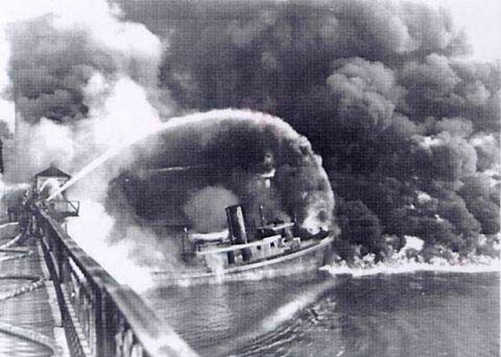
Credit: U.S. Environmental Protection Agency
You might not think a river can burn. But in 1969, the Cuyahoga River that runs through Cleveland caught fire.
The Cuyahoga was the most polluted river in the country, so fouled with industrial waste and sewage that it was completely devoid of life when a spark from a passing freight train ignited an oil slick that covered the water.
The river had burned at least 10 times in the previous 100 years, but that short 1969 fire was when Cleveland said “enough.”
A new mayor and young city architect launched an ambitious plan to rebuild the city sewage system, regulate industrial polluters and clean the river itself. It would be expensive, but the city put it to a vote, and it passed two to one.
The Cuyahoga River fire hit the news cycle along with the Apollo 11 moon landing, and the nation took notice.
Environmental movements sprung up on campuses, which led to the founding of Earth Day in 1970. Simultaneously, President Nixon was inspired to create the Environmental Protection Agency.
Now more than 50 years later, the Cuyahoga has rebounded with life, enough that fish from the river are now deemed fit to eat. In 2019, it was named the nation’s River of the Year for its remarkable recovery.
It’s a pity that it ever got that bad. But it just goes to show that, as we put our minds to it, we’re solving even serious environmental problems.
Background
Synopsis: In the 1960s, Ohio’s Cuyahoga River was considered the most polluted river in the country, completely barren of life in the 38 mi (61 km) stretch between the cities of Akron and Cleveland. Oil slicks on the river caught fire more than a dozen times from 1868 to 1969, but it was the fairly small blaze on June 22, 1969, that sparked a national movement to clean up polluted waterways, resulting in the Clean Water Act, Earth Day and President Nixon’s creation of the Environmental Protection Agency. In 2019, the Cuyahoga was named River of the Year for its 50 years of resurgence.
- The Cuyahoga River empties into Lake Erie through the center of the city of Cleveland, in northeastern Ohio. Most of the river is just 3 to 6 ft (1–2 m) deep.
- The river originally flowed southward, but changes in drainage patterns caused by the final retreat of the Pleistocene ice sheets reversed its direction.
- The river carved its U-shaped course around a moraine of glacial debris left behind as ice sheets retreated northward, making its path nearly 100 mi (160 km) long when its headwaters are just 30 mi (50 km) from the lakeshore.
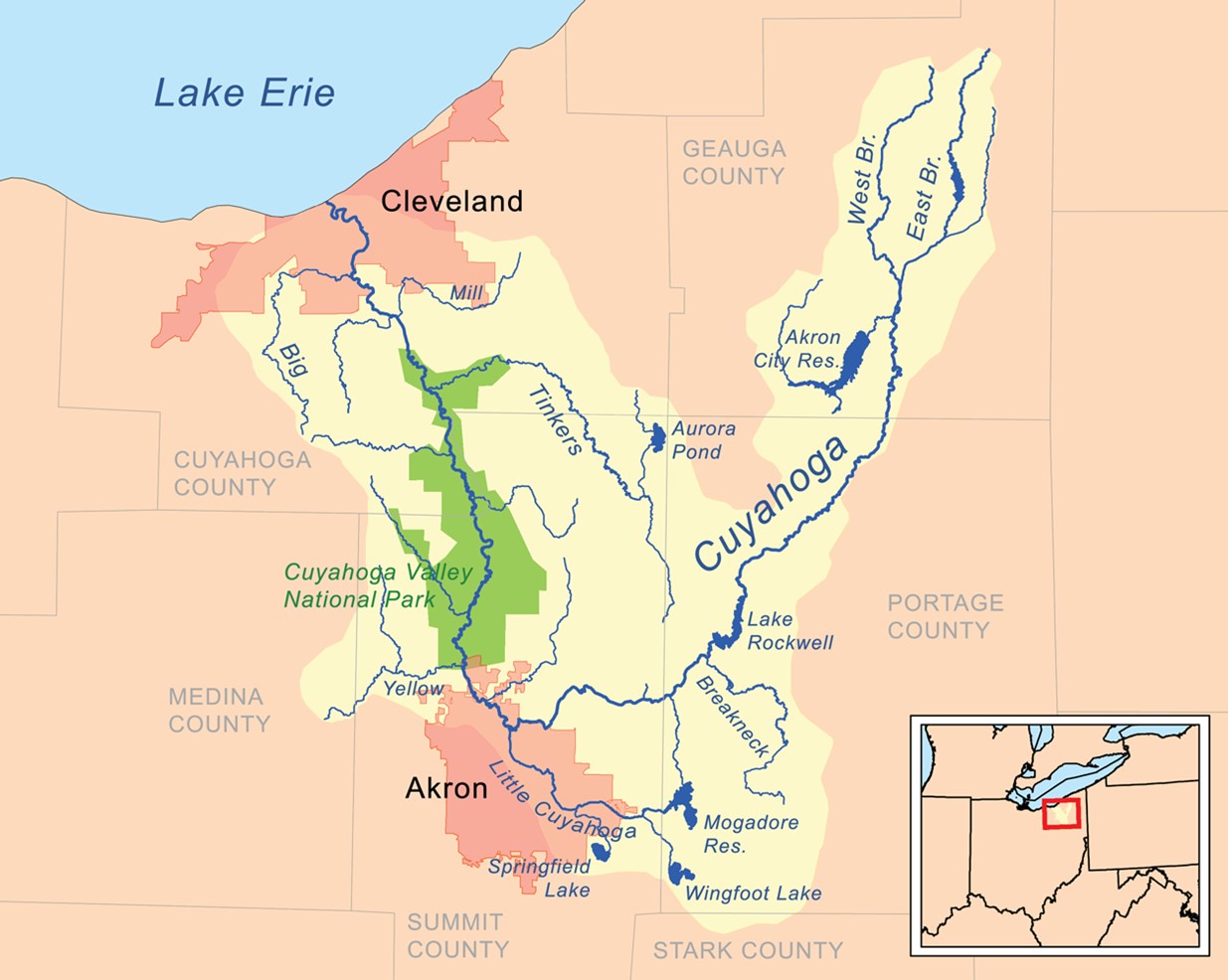
Map of the Cuyahoga River drainage basin in northeastern Ohio. With its U-shaped course, the name Cuyahoga is believed to come from Onödowáʼga꞉ (the people called Seneca by English colonists) words meaning “place of the jawbone” or from "crooked river" in the Kanienʼkehá꞉ka (Mohawk to English colonists) language.
Credit: Kmusser, CC BY-SA 3.0, via Wikimedia Commons
- The town of Cleaveland was established by General Moses Cleaveland at the mouth of the Cuyahoga River in 1796, but its name was quickly shortened to Cleveland.
- Along the U.S. maritime border with Canada, Cleveland quickly became the largest city on Lake Erie.
- In 1825, the Erie Canal opened, connecting Lake Erie to New York’s Hudson River. In 1832, the Ohio and Erie Canal opened, linking the Ohio River along the southern border of the state with Lake Erie on its north, with passage from Cincinnati to Cleveland in just 80 hours (speedy for the era!).
- John D. Rockefeller founded Standard Oil in Cleveland in 1870, moving its headquarters to New York City in 1885.
- The emerging commercial and industrial port city and railroad hub was a trade center for grain, then lumber, then coal and, finally, iron ore in 1888, attracting many immigrants looking for employment.
- Iron ore from the Marquette Range in the Upper Peninsula of Michigan fed the smelters and steel mills of Cleveland.
- In 1959, Cleveland was connected to the Atlantic via the St. Lawrence Seaway.
- During parts of the 20th century, the shallow Cuyahoga River was considered to be the most polluted river in the United States, resulting from decades of industrial pollution along its course.
- The river’s oil slicks caught fire many times since the first documented fire in 1868 (1883, 1887, 1912, 1922, 1936, 1941, 1948, 1952 and 1969). Historians believe there may have been 20 to 30 more, as smaller fires may not have been recorded.
- The largest fire, in 1952, caused $1 million in damage (worth more than $11 million in today’s dollars) to three tugboats, a bridge, three office buildings and the shipyards on the river.
- During the 1950s and 1960s, no fish lived in the 40 mi (65 km) section between Akron and Cleveland. Nothing could live in water that was so polluted that it was depleted of oxygen.
- For much of the city’s history, residents thought of pollution as an unavoidable consequence of the industrial prosperity of the city, but this began to change in the 1960s when Mayor Carl Stokes was elected (the first black mayor of a large U.S. city).
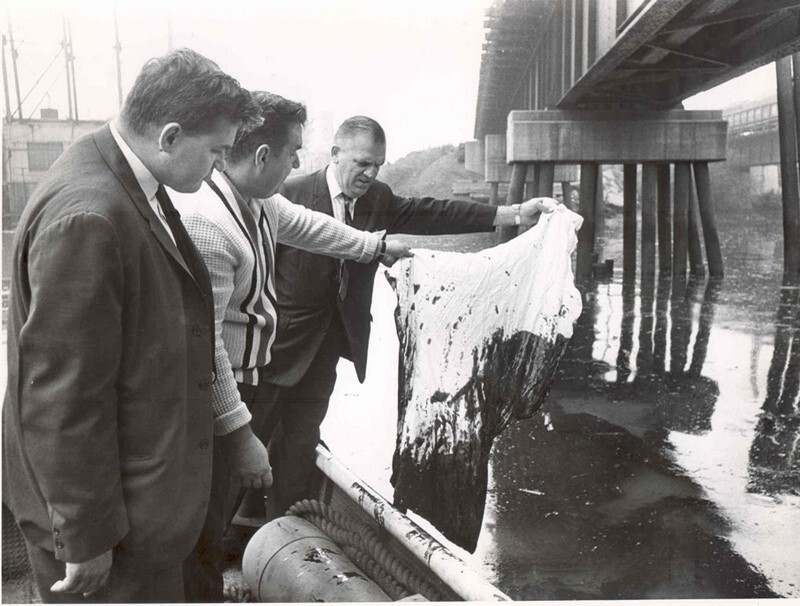
Three Cleveland city councilmen inspect evidence of oil pollution in the Cuyahoga River in September 1964.
Credit: Jerry Horton via the Cleveland Memory Project, Cleveland State University Library Special Collections- In 1968, a talk given at a Kent State University symposium described a stretch of the river that runs through Cleveland as follows: “The surface is covered with the brown oily film observed upstream as far as the Southerly Plant effluent. In addition, large quantities of black heavy oil floating in slicks, sometimes several inches thick, are observed frequently. Debris and trash are commonly caught up in these slicks forming an unsightly floating mess. Anaerobic action is common as the dissolved oxygen is seldom above a fraction of a part per million. The discharge of cooling water increases the temperature by 10 to 15°F (5.6 to 8.3°C). The velocity is negligible, and sludge accumulates on the bottom. Animal life does not exist. Only the algae Oscillatoria grows along the piers above the water line. The color changes from gray-brown to rusty brown as the river proceeds downstream. Transparency is less than 0.5 ft (0.15 m) in this reach. This entire reach is grossly polluted.”
Credit: The Cuyahoga River Watershed: Proceedings of a Symposium Commemorating the Dedication of Cunningham Hall, Kent State University, November 1, 1968. - In 1968, a $100 million bond (worth more than $900 million in today’s dollars) for Cuyahoga cleanup, to improve existing facilities and build 25 miles of trunk-line sewers plus a modern sewage treatment plant, was passed by 66% of the citizens of Cleveland at the behest of Cleveland’s Director of Public Utilities Ben Stefanski and Mayor Stokes.
- The fate of the river had started to change, thanks to local initiatives.
- In 1968, a talk given at a Kent State University symposium described a stretch of the river that runs through Cleveland as follows: “The surface is covered with the brown oily film observed upstream as far as the Southerly Plant effluent. In addition, large quantities of black heavy oil floating in slicks, sometimes several inches thick, are observed frequently. Debris and trash are commonly caught up in these slicks forming an unsightly floating mess. Anaerobic action is common as the dissolved oxygen is seldom above a fraction of a part per million. The discharge of cooling water increases the temperature by 10 to 15°F (5.6 to 8.3°C). The velocity is negligible, and sludge accumulates on the bottom. Animal life does not exist. Only the algae Oscillatoria grows along the piers above the water line. The color changes from gray-brown to rusty brown as the river proceeds downstream. Transparency is less than 0.5 ft (0.15 m) in this reach. This entire reach is grossly polluted.”
- Then, on Sunday morning, June 22, 1969, a spark from a passing freight train ignited an oil slick on the river near the Republic Steel mill.
- It caused a smoky fire that resulted in about $50,000 worth of damage (equivalent to more than $400,000 worth of damage in today’s dollars) to two railroad bridges during the 30 minutes that it burned.
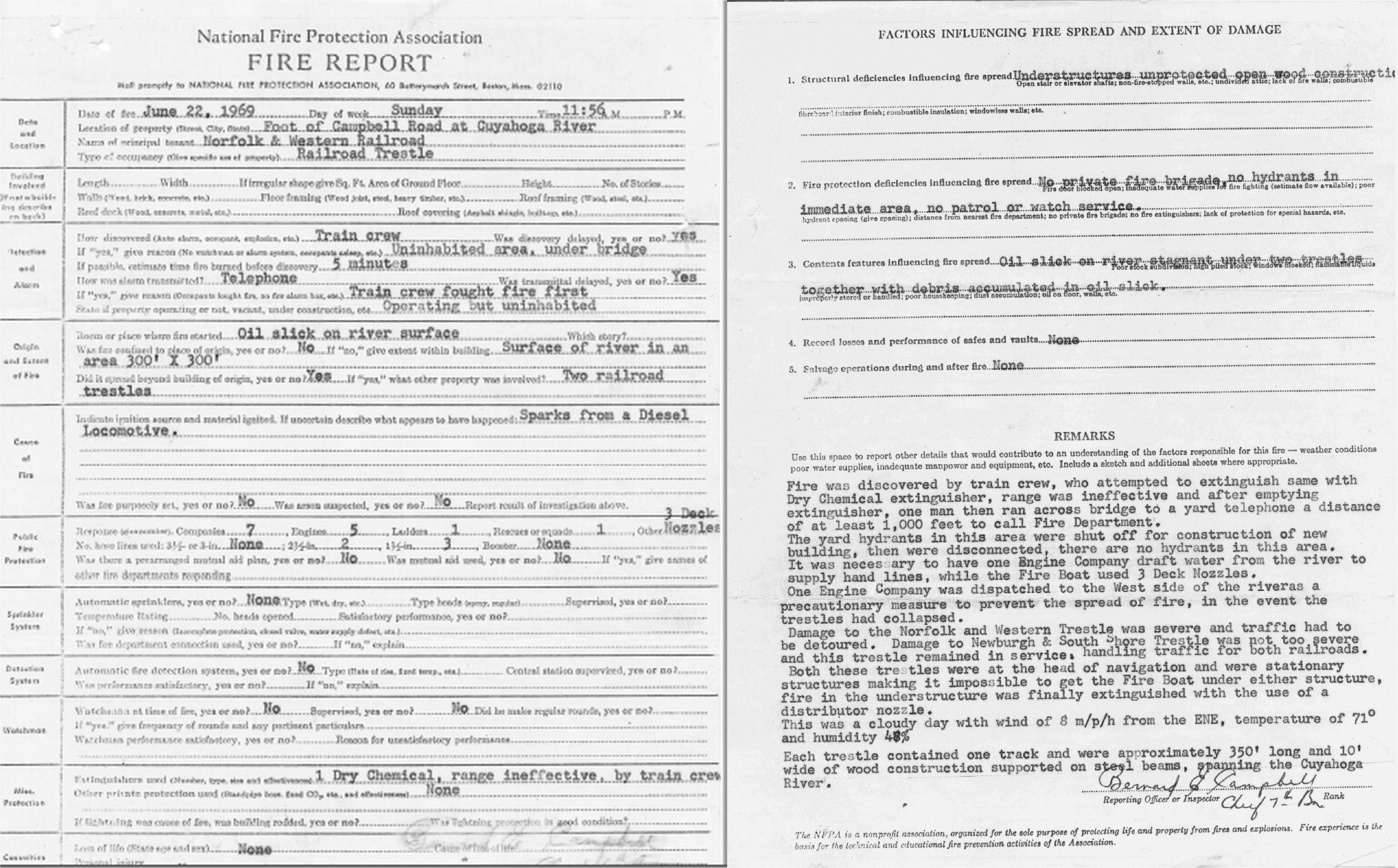
Original Cleveland Fire Department report regarding the June 22, 1969, Cuyahoga River fire.
Credit: Original report of the 1969 Cuyahoga River fire, via Cuyahoga50 special series at Cleveland.com - The event was so short that no pictures were taken. Most pictures that run with this story are of the larger 1952 fire.
- Nobody gave the incident much thought except Mayor Stokes. It wasn’t considered a major news story in Cleveland that day.
- However, a Time Magazine article published that summer, on August 1, 1969, drew attention to the fire and similar incidents on waterways elsewhere in the country, creating an uproar: “Some river! Chocolate-brown, oily, bubbling with subsurface gases, it oozes rather than flows. ‘Anyone who falls into the Cuyahoga does not drown,’ Cleveland's citizens joke grimly. ‘He decays.’ The Federal Water Pollution Control Administration dryly notes: ‘The lower Cuyahoga has no visible life, not even low forms such as leeches and sludge worms that usually thrive on wastes.’ It is also—literally—a fire hazard.”
- It didn’t hurt that the issue of Time with the polluted waterways story featured the Apollo 11 astronauts and the moon landing and led with a cover story about Ted Kennedy and the Chappaquiddick tragedy in which Mary Jo Kopechne drowned.
- It caused a smoky fire that resulted in about $50,000 worth of damage (equivalent to more than $400,000 worth of damage in today’s dollars) to two railroad bridges during the 30 minutes that it burned.
- The small Cuyahoga fire on that day, the Time Magazine article about it, and a major oil spill near Santa Barbara, California spurred on a growing groundswell of concern about pollution that resulted in tangible actions.
- Senator Gaylord Nelson of Wisconsin organized a “teach-in” on college campuses on April 22, 1970, in which 10% of the United States population participated. This protest was the starting point for Earth Day celebrations, still going strong decades later.
- It ultimately led to President Nixon’s creation of the federal Environmental Protection Agency (EPA) in 1970, with its first Director, William Ruckelshaus, sworn in on December 4, 1970.
- It drove action on many water pollution concerns in the country, including the 1972 amendments to the 1948 Water Pollution Control Act and the Great Lakes Water Quality Agreement of 1972 (currently known as the Great Lakes Area of Concern).
- State offices like the Ohio Environmental Protection Agency (OEPA) worked with local communities to clean up the Cuyahoga and other polluted bodies of water. Today, the river looks like a river should!
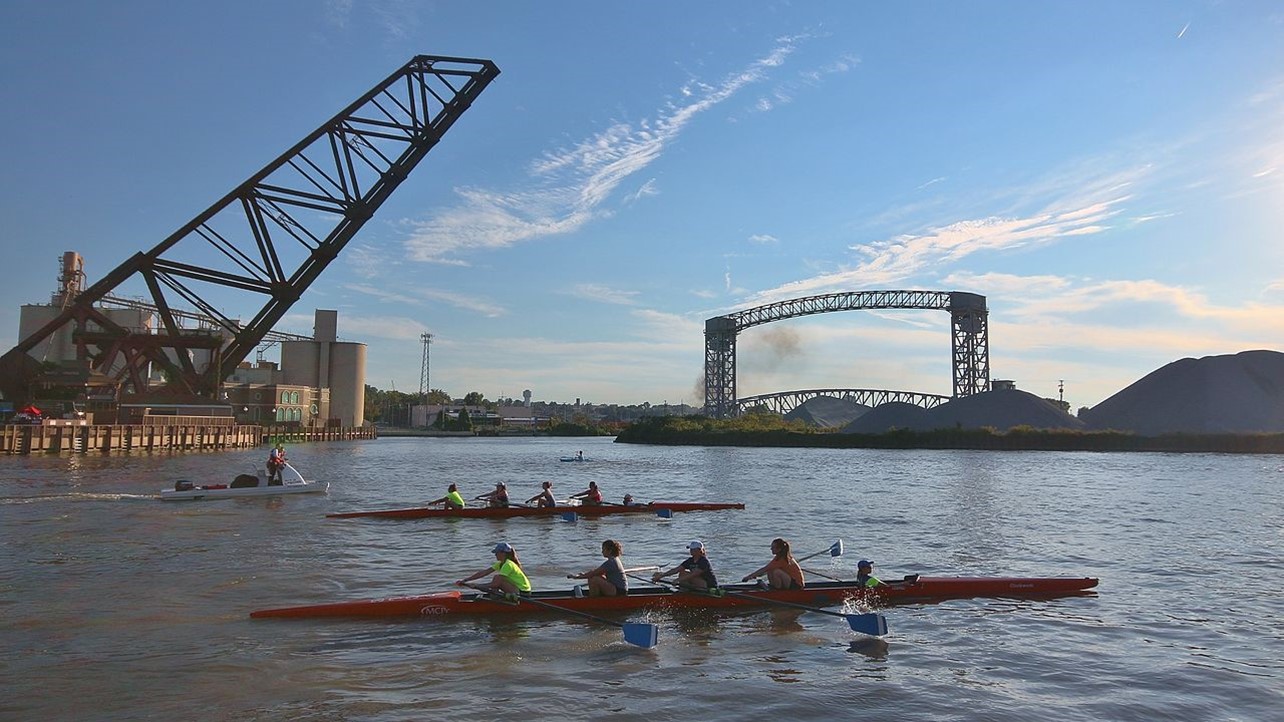
Rowing on the Cuyahoga in Cleveland in 2015
Credit: k_e_lewis, CC BY 2.0, via Wikimedia Commons- In March 2019, federal environmental regulators finally declared fish caught from the Cuyahoga safe to consume (although a tanker fuel spill on the river caused a brief fire on the river in August 2019).
- Cleveland and the Cuyahoga have now been recognized as an environmental success story. In 2019, it was named River of the Year, honoring 50 years of environmental resurgence by the American Rivers Conservation Association.
- Today, Cleveland is home to the Cleveland Browns football team, the Home of Superman (creator Jerry Siegel’s house), the Rock and Roll Hall of Fame, and a cleaner Cuyahoga River.

